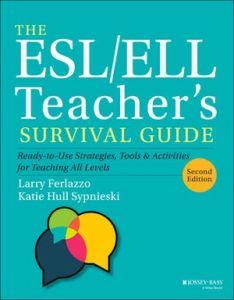An “Eminently Practical” Guide to Teaching ELLs
A MiddleWeb Blog
ENL educator Dina Strasser completes her review of The ESL/ELL Teacher’s Survival Guide that she began here.

Where Part 2 addressed the needs of beginning ELLs, Part 3 picks up the thread by discussing the intermediate learner – an under-recognized area of need and perhaps the level that includes the largest population of ELL students.
As students grow older and the curriculum deepens, the linguistic demands on ELLs increase, thus slowing down the rapid gains they often make in the emerging levels of acquisition. Most of my middle school students naturally end up in the intermediate level for some time and if they are not challenged enough, they can languish there.
Keeping the language train on the tracks
Ferlazzo and Sypnieski’s recipe for keeping the intermediate language train on the tracks includes (among many helpful ingredients) free voluntary reading, explicit academic vocabulary instruction, scaffolding difficult texts, clozes and text data sets, mentor texts, videos, and supportive, targeted homework that reinforces language learning in school.
What all of these strategies have in common is increasing the accessibility of academic text without decreasing its rigor, which is key for intermediate language learners.

It’s important to note that “free voluntary reading,” in order to be effective, is neither really free nor voluntary; it involves a great deal of teacher conferencing, reflection through writing, practice at home, and guidelines for choosing books that are neither too easy nor too difficult for the student.
Meeting ELL’s needs in mainstream classes
Parts Four and Five take up the perennial challenge of how to handle ELLs in the mainstream classroom and in specific groups (adult learners, elementary learners, and learners with special needs). The book takes pains to define itself as a “starting point” for mainstream teachers of ELLs, versus a definitive guide; and indeed, it’s in these later sections that I find myself longing for more clarity. The “Organizing Cycle” the authors suggest as a framework for approaching mainstream lesson planning for ELLs has five steps, for example, but these are not summarized or linked in a graphic or chart for the reader.
Similarly, the content specific sections – Math, Science and Social Studies – while helpful, are all organized differently, which makes navigating their dense informative text more work than it needs to be. Section Five devotes only six pages to the exceptionally thorny and critical issue of meeting the needs of ELLs who may also seem to exhibit learning differences, but 15 pages to adult ELLs, whom most secondary ELL teachers may never teach. As a K-12 teacher, I would have balanced these treatments differently.
An eminently practical resource for the novice and the expert
Part Six serves as the “kitchen sink” finale, and has some really lovely components to it: outlining the “qualities of a good learning game” is a favorite, and an oft-overlooked issue where games and gamifying have swept the teaching scene.
While the book gives only the briefest of glosses to assessment, another critical component of teaching ELLs, we don’t need to worry. In this book, assessment – of learning, as learning and for learning – is baked in to every page. Implementing its rich bank of strategies will increase the efficacy of your assessment of ELL learning in an extremely practical way.
And this brings us full circle to the great gift of The ESL/ELL Teacher’s Survival Guide: its eminent practicality. For the novice or the expert teacher, reading and making use of Ferlazzo and Sypnieski’s advice will demonstrably strengthen your work with ELL students, who arguably need quality teaching the most of all.


































